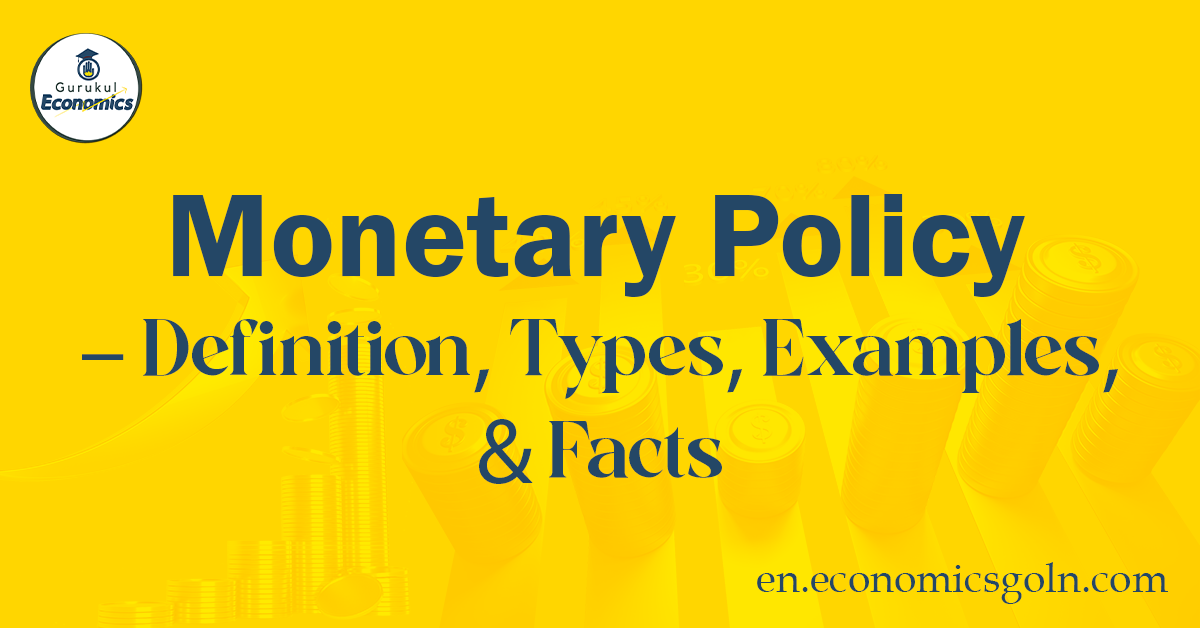Monetary policy plays a crucial role in shaping a country’s economy by influencing the availability and cost of money, credit, and the overall financial conditions. Implemented by the central banks of nations worldwide, monetary policy is a powerful tool used to manage inflation, stabilize exchange rates, promote economic growth, and maintain financial stability. In this article, we will explore the definition, types, examples, and important facts about monetary policy.

Definition of Monetary Policy: Monetary policy refers to the actions taken by a country’s central bank to control and regulate the money supply and interest rates within the economy. It aims to achieve specific macroeconomic objectives, such as controlling inflation, stabilizing the economy during periods of recession or expansion, and ensuring price stability. Central banks use various tools and strategies to implement monetary policy and exert influence on economic activity.

Types of Monetary Policy:
Expansionary Monetary Policy:
An expansionary monetary policy is typically employed during economic downturns or recessions. Its primary objective is to stimulate economic growth by increasing the money supply, lowering interest rates, and encouraging borrowing and spending. By making credit more accessible, this policy aims to boost investment, consumption, and overall economic activity.
Contractionary Monetary Policy:
Contractionary monetary policy is implemented to curb inflationary pressures within an economy. It involves reducing the money supply, raising interest rates, and encouraging savings. By making borrowing more expensive, this policy seeks to limit spending, control inflation, and stabilize the economy during periods of excessive growth or potential asset bubbles.

Examples of Monetary Policy:
Interest Rate Adjustments:
Central banks commonly use interest rate adjustments as a tool to implement monetary policy. By raising or lowering interest rates, they influence borrowing costs for individuals, businesses, and financial institutions. Lowering interest rates encourages borrowing and stimulates economic activity, while raising interest rates reduces borrowing and slows down economic growth.
Open Market Operations:
Open market operations involve the buying and selling of government securities by the central bank in the open market. If the central bank wants to increase the money supply, it purchases government securities from banks, injecting money into the economy. Conversely, if it wants to reduce the money supply, it sells government securities, removing money from circulation.
Reserve Requirements:
Central banks may establish reserve requirements, which mandate that financial institutions hold a certain percentage of their deposits as reserves. By adjusting these requirements, central banks can influence the amount of money that banks can lend. Lowering reserve requirements increases the funds available for lending, promoting economic activity, while raising them restricts lending and slows down economic growth.

Facts about Monetary Policy:
Independence of Central Banks:
To maintain the effectiveness of monetary policy, central banks are often granted a degree of independence from the government. This independence allows them to make decisions based on economic considerations rather than short-term political objectives, thereby ensuring the stability and credibility of monetary policy.
Inflation Targeting:
Many central banks adopt an inflation targeting framework as part of their monetary policy strategy. Inflation targeting involves setting specific inflation rate targets and adjusting monetary policy instruments to achieve those targets. By focusing on price stability, central banks aim to provide a stable economic environment conducive to sustainable growth.
Global Interconnectedness:
Monetary policy actions in one country can have spillover effects on other nations due to global interconnectedness. Changes in interest rates or exchange rates in one country can impact capital flows, trade, and economic conditions in other countries. Central banks often need to consider these external factors when formulating and implementing their monetary policy.
Time Lags:
Monetary policy measures typically have a lagged effect on the economy. Changes in interest rates or money supply take time to permeate through the financial system and influence borrowing and spending decisions. As a result, central banks need to anticipate economic trends and adjust monetary policy in advance to achieve desired outcomes.

Monetary policy is a vital tool used by central banks to manage and stabilize economies. By influencing the money supply, interest rates, and financial conditions, monetary policy seeks to achieve specific macroeconomic objectives such as price stability, economic growth, and financial stability. Understanding the various types, examples, and facts about monetary policy helps shed light on the complex and impactful role it plays in shaping economies worldwide.
See more:
